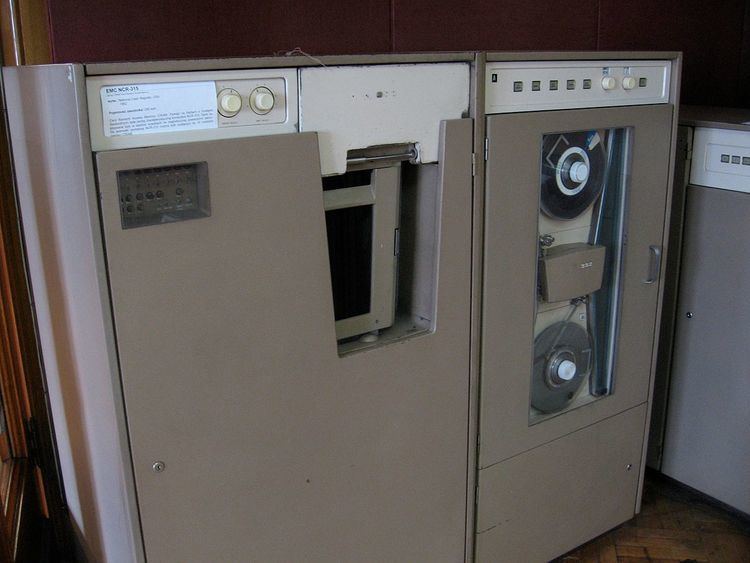 | ||
The NCR 315 Data Processing System, released in January 1962 by NCR, was a second-generation computer. All printed circuit boards used resistor-transistor logic to create the various logic elements. It used 12-bit slab memory structure using core memory. The instructions could use a memory slab as either two 6-bit alphanumeric characters or as three 4-bit BCD characters. Basic memory was 5000 "slabs" of handmade core memory, which was expandable to a maximum of 40,000 slabs in four refrigerator-size cabinets. The main processor included three cabinets and a console section that housed the power supply, keyboard, output writer (an IBM electric typewriter), and a panel of lights that indicated the current status of the program counter, registers, arithmetic accumulator, and system errors. Input/Output was by direct parallel connections to each type of peripheral through a two-cable bundle with 1-inch-thick cables. Some devices like magnetic tape and the CRAM were daisy-chained to allow multiple drives to be connected.
Contents
Later models in this series include the 315-100 and the 315-RMC (Rod Memory Computer).
Memory organization
The addressable unit of memory on the NCR 315 series is a "slab", short for "syllable", consisting of 12 data bits and a parity bit. Its size falls between a byte and a typical word (hence the name, 'syllable'). A slab may contain three digits (with at sign, comma, space, ampersand, point, and minus treated as digits) or two alphabetic characters of six bits each. A slab may contain a decimal value from -99 to +999.
A numeric value contains up to eight slabs. If the value is negative then the minus sign is the leftmost digit of this row. There are instructions to transform digits to or from alphanumeric characters. These commands use the accumulator, which has a maximum length of eight slabs. To accelerate the processing the accumulator works with an effective length.
NCR 315-100
The NCR 315-100 was the second version of the original 315. It too had a 6 microsecond clock cycle, and from 10,000 to 40,000 slabs of memory. The 315-100 series console I/O incorporated a Teletype printer and keyboard in place of the original 315's IBM typewriter.
The primary difference between the older NCR 315 and the 315-100 was the inclusion of the Automatic Recovery Option (ARO). One of the problems with early generation of computers was that when a memory or program error occurred, the system would literally turn on a red light and halt. The normal recovery process was to copy all register and counter setting from the console light panel, and to restart the program that was running at the time of the error. Usually the restart was from the very beginning of the program.
The upgrade to the 315 required the removal of approximate 1800 wire-wrapped connection on the backplane, and the installation of approximately 2400 new point-to-point wired connection.
NCR 315-RMC
The NCR 315-RMC, released in July 1965, was the first commercially available computer to employ thin film memory. This reduced the clock cycle time to 800 nanoseconds. It also included floating-point logic to allow scientific calculations, while retaining the same instruction set as previous NCR 315 and NCR 315-100.
The thin film was wrapped around "rods" to allow faster reading and writing of memory.
Its follow-on was the NCR Century series.
